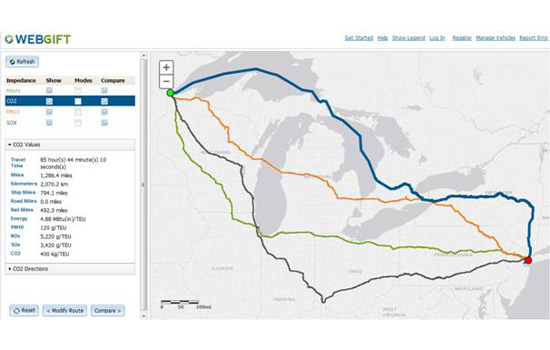Team unveils Web-based program for shipping routes
Shipping companies, government agencies able to virtually analyze environmental impact of freight transportation
Researchers from RIT and University of Delaware have collaborated with the U.S. Department of Transportation’s Maritime Administration to create a Web-based version of the Geospatial Intermodal Freight Transportation System. The new system analyzes the time-of-delivery and environmental performance of various freight-transportation routes using road, rail and water.
A new Web-based version of the Geospatial Intermodal Freight Transport Model, or GIFT, has been released as part of a five-year research initiative among researchers at Rochester Institute of Technology, University of Delaware and the U.S. Department of Transportation’s Maritime Administration. The model, which utilizes geospatial mapping software, analyzes the time-of-delivery and environmental performance of various freight-transportation routes using rail, road and water. With this Web-based version, companies and local, state and federal government agencies can make decisions through an interactive map that are not only financially feasible, but also environmentally sustainable.
For example, a company can evaluate the greenhouse gas emissions associated with moving goods along various freight corridors using different transportation modes, and choose options that meet corporate goals, customer desires and regulatory mandates.
The Web-based system, called WebGIFT, includes updated transportation connections between the U.S. and Canada and Mexico; estimated road-speed data for more accurate travel calculations between origin and destination points; and tested case studies that reveal which shipping routes may produce lower emissions and lower energy use. A key feature of WebGIFT is that emissions rates; truck, train, and ship operating characteristics; and other variables can be adjusted to reflect a variety of operating scenarios that best reflect the user’s needs and future energy and emission standards.
Funding was initially secured in 2010 under the Sustainable Intermodal Freight Transportation Research program, a collaborative effort aimed at improving freight decision through innovative, data-driven, transformative research in four key areas: energy, environmental and economics analysis; congestion and modal analysis; safety, security and infrastructure resilience; and data acquisition, storage and access.
The U.S. Department of Transportation was an active partner in the development and roll-out of WebGIFT, providing modal data necessary for the calculation of travel times, and awarding the project numerous grants through the Maritime Administration (a DOT agency). Chief authority of the Maritime Administration, Acting Maritime Administrator Paul “Chip” Jaenichen commented on the WebGIFT release, stating that “economic and environmental considerations must go hand-in-hand with America’s growing requirements for freight movement. Thankfully, WebGIFT is just the tool planners and policy analysts need to responsibly meet our nation’s mobility needs. Both the Department of Transportation and the Maritime Administration are proud of the supporting roles we played in bringing this great project to completion.”
James Winebrake, dean of RIT’s College of Liberal Arts and one of the primary researchers on the GIFT project, explained the value of using the new Web-based system.
“For instance, a company planning to move goods from Hong Kong to New York City can use GIFT to evaluate time-of-delivery and environmental impacts associated with this freight movement,” he said. “They can also use the model to explore how environmental impacts may be reduced using alternative routes or modes of transportation, and what the time-of-delivery tradeoffs associated with these alternatives may be. In one published case study, we show how the type of vessel used to move goods can greatly affect environmental performance, and how trains and trucks can be used to supplement domestic and international shipping to make the entire freight delivery system more effective and efficient.”
The collaboration with the U.S. Department of Transportation’s Maritime Administration builds on research conducted by Winebrake; Karl Korfmacher, associate professor of environmental science (RIT); Scott Hawker, associate professor of software engineering (RIT); and James Corbett, professor of marine policy at the University of Delaware’s College of Earth, Ocean, and Environment.
“Visualizing 21st century freight innovation will help engage all partners in the supply chain see where energy savings, environmental targets, and economic choices serve a sustainable triple bottom line,” according to Corbett.
“With the help of talented undergraduate and graduate students, we are delighted to deliver innovation and value through WebGIFT,” Hawker said.
“This work also highlights our interest in interdisciplinary research,” added Winebrake. “By bringing together faculty and researchers from various disciplines, we can create innovative solutions that pair operational feasibility with environmental sustainability.”














